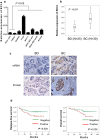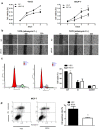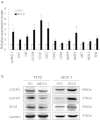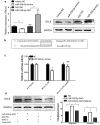B-cell lymphoma 6 protein stimulates oncogenicity of human breast cancer cells
- PMID: 24917186
- PMCID: PMC4065600
- DOI: 10.1186/1471-2407-14-418
B-cell lymphoma 6 protein stimulates oncogenicity of human breast cancer cells
Abstract
Background: B-cell lymphoma 6 (BCL6) protein, an evolutionarily conserved zinc finger transcription factor, showed to be highly expressed in various human cancers in addition to malignancies in the lymphoid system. This study investigated the role of BCL6 expression in breast cancer and its clinical significance in breast cancer patients.
Methods: Expression of BCL6 protein was assessed using in situ hybridization and immunohistochemistry in 127 breast cancer patients and 50 patients with breast benign disease as well as in breast cell lines. Expression of BCL6 was restored or knocked down in two breast cancer cell lines (MCF-7 and T47D) using BCL6 cDNA and siRNA, respectively. The phenotypic change of these breast cancer cell lines was assessed using cell viability MTT, Transwell invasion, colony formation, and flow cytometry assays and in a xenograft mice model. Luciferase reporter gene, immunoblot, and qRT-PCR were used to investigate the molecular events after manipulated BCL6 expression in breast cancer cells.
Results: BCL6 protein was highly expressed in breast cancer cell lines and tissue specimens and expression of BCL6 protein was associated with disease progression and poor survival of breast cancer patients. In vitro, the forced expression of BCL6 results in increased proliferation, anchorage-independent growth, migration, invasion and survival of breast cancer cell lines, whereas knockdown of BCL6 expression reduced these oncogenic properties of breast cancer cells. Moreover, forced expression of BCL6 increased tumor growth and invasiveness in a nude mouse xenograft model. At the gene level, BCL6 was a target gene of miR-339-5p. Expression of BCL6 induced expression of CXCR4 and cyclinD1 proteins.
Conclusions: The current study demonstrated the oncogenic property of BCL6 in breast cancer and further study could target BCL6 as a novel potential therapeutic strategy for breast cancer.
Figures






References
Publication types
MeSH terms
Substances
LinkOut - more resources
Full Text Sources
Other Literature Sources
Medical

